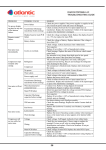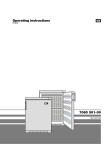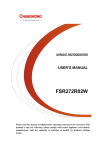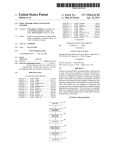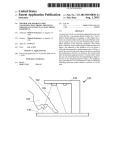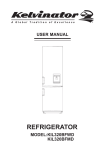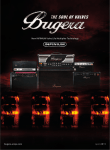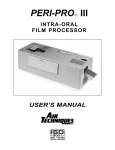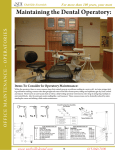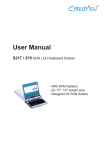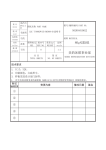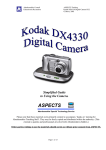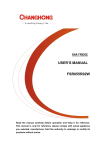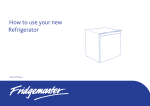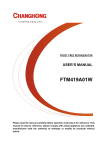Download - Changhong
Transcript
FULL FREEZER USER’S MANUAL FSF089R02W SAFETY WARNING! It is hazardous for anyone other than authorized service personnel to carry out servicing or repairs which involves the removal of covers. To avoid the risk of an electric shock do not attempt to repair this appliance yourself. Safety tips Do not use electrical appliances such as a hair dryer or heater to defrost your Freezer. Containers with flammable gases or liquids can leak at low temperatures. Do not store any containers with flammable materials, such as spray cans, fire extinguisher refill cartridges etc. in the Freezer. Do not place carbonated or fizzy drinks in the Freezer compartment. Ice lollies can cause “Frost/Freeze burns”. If consumed straight from the Freezer. Do not remove items from the Freezer compartment if your hands are damp/wet, as this could cause skin abrasions or “Frost/Freezer burns”. Bottles and cans must not be placed in the Freezer compartment as they can burst when the contents freeze. Manufacturer’s recommended storage times should be adhered to. Refer to relevant instructions. Do not allow children to tamper with the controls or play with the Freezer. The Freezer is heavy. Care should be taken when moving it. It is dangerous to alter the specification or attempt to modify this product in any way. Do not store inflammable gases or liquids inside you Freezer. 1 If the power cable is damaged, it must be replaced by the manufacturer, its service agent or similarly qualified persons in order to avoid a hazard. The appliance is not to be used by persons (including children) with reduced physical, sensory or mental capabilities, or lack of experience and knowledge, unless they have been given supervision or instruction This appliance is intended to be used in household and similar applications such as ·staff kitchen areas in shops, offices and other working environments; ·farm houses and by clients in hotels, motels and other residential type environments; ·bed and breakfast type environments; ·catering and similar non-retail applications. Keep ventilation openings, in the appliance enclosure or in the built-in structure, clear of obstruction. Do not use mechanical devices or other means to accelerate the defrosting process, other than those recommended by the manufacturer. Do not damage the refrigerant circuit. Do not use electrical appliances inside the food storage compartments of the appliance, unless they are of type recommended by the manufacturer. Do not store explosive substances such as aerosol cans with a flammable propellant in this appliance. Disposal Old appliances still have some residual value. An environmentally friendly method of disposal will ensure that valuable raw materials can be recovered and used again. The refrigerant used in your appliance and insulation materials requires special disposal procedures. Ensure that none of the pipes on the back of the appliance are damaged prior to disposal. Up to date information concerning options for disposing of your old appliance and packaging from the new one can be obtained from your local council office. Locks If your Freezer is fitted with a lock, to prevent children being entrapped keep the key out of 2 reach and not in the vicinity of the appliance. If disposing of an old Freezer break off any old locks or latches as a safeguard. INTRODUCTION Before use Please read these instructions and the Safety guidelines on page 1 carefully before using your new Freezer. The Freezer is for indoor, domestic use only. 1 Top cover 2 Display Block 3 Freezer Flap 4 Middle Drawer 5 Low Drawer 6 Adjustable feet INSTALLATION Location When selecting a position for your Freezer you should make sure the floor is flat and firm, and the room is well ventilated with an average room temperature of between 16℃ and 43℃. Avoid locating your Freezer near a heat source, eg, cooker, boiler or radiator. Also avoid direct sunlight in out-buildings or sun lounges. If you are placing your Freezer in an out-building such as a garage or annex ensure that the Freezer is placed above the damp course, otherwise condensation will occur on the Freezer cabinet. Never place the Freezer in a wall recessed or into fitted cabinets or fumiture when your Freezer is working, the grille at the back may become hot and the sides warm. It must therefore be installed so that the back of the Freezer has at least 9cm(31/2 ) of free space and the sides have 2cm(3/4 ).The appliance dimensions (W×D×H) is 545×566×845mm. Do not drape the Freezer with any covering. 3 Leveling the Freezer If the Freezer is not level, the door and magnetic seal alignment will be affected and may cause you Freezer to work incorrectly. Once the Freezer is placed in its final location, adjust the leveling feet at the front by turning them. Cleaning before use Wipe the inside of the Freezer with a weak solution of bicarbonate of soda. Then rinse with warm water using a damp sponge or cloth. Wash the baskets and shelves in warm soapy water and dry completely before replacing in the Freezer. The external parts of the Freezer can be cleaned with wax polish. See page 6 for more details on cleaning. Before plugging in YOUMUST Check that you have a socket which is compatible with the plug supplied with the Freezer. If not see the section called ELECTRICAL INFORMATION on page 8. Before switching on! DO NOT SWITCH ON UNTIL FOUR HOURS AFTER MOVING THE FREEZER. The coolant fluid needs time to settle. If the appliance is switched off at any time, wait 30 minutes before switching back on to allow the coolant fluid to settle. Before filling your Freezer Before storing foods in your Freezer, turn the Freezer on and wait for 24 hours, to make sure it is working properly and to allow the Freezer to fail to the correct temperature. See page 5 for more details. START Testing 1.Clean the freezer with lukewarm water and detergent,and wipe dry. Note: Electrical components should be cleaned with a dry cloth. 2.Turn the thermostat knob to the 2 position, and plug the freezer into the wall 4 outlet.The compressor will begin to run. 3. Check, after 30 minutes of operation, to ensure that the freezer is cold. Temperature Control 1. The temperature control (thermostat knob,turned by coin) is located near the top of the unit. 2.Turning the thermostat knob adjusts the temperature of the freezer. 3.The marks on the knob represent different settings. Setting 1 is the warmest and setting 4 is the coolest. 4. The factory recommended setting is 2 for normal operating conditions. IN USE 1. The appliance might not operate consistently (possibility of defrosting of contents or temperature becoming too warm in the frozen food compartment) when sited for an extended period of time below the cold end of the range of temperatures for which the refrigerating appliance is designed 2. The fact that the climate class is T, and the room temperature of between 16℃ and 43℃. 3. The fact that the internal temperatures could be affected by such factors as the location of the refrigerating appliance, ambient temperature and the frequency of door opening, and, if appropriate, a warning that the setting of any temperature control device might have to be varied to allow for these factors 4. The fact that effervescent drinks should not be stored in food freezer compartments or cabinets or in low-temperature compartments or cabinets, and that some products such as water ices should not be consumed too cold 5. The need to not exceed the storage time(s) recommended by the food manufacturers for any kind of food 6. The fact that a rise in temperature of the frozen food during manual defrosting, maintenance or cleaning could shorten the storage life 7. It is better wrapping the frozen food in several layers of the glass shelves. 8. The care required with regard to frozen food in storage in the event of an extended non-running of the refrigerating appliance (interruption of power supply or failure of the refrigerating system) 9. The door to the evaporator clearance can be used to store food. 5 Tips and Hints 1.Food should be wrapped in aluminum foil, or some other type of airtight packing. 2.Do not allow frozen food in freezer to touch foods just placed into freezer. It can damage the food. 3.Frozen foods from the store should be placed in the freezer promptly, so they do not thaw. 4.Never place fresh vegetables and fruits into the freezer as they can get freezer burn. Recommended storage periods For recommended food storage time, refer to the information given on your food packaging. Defrosting 1.When the freezer operates for a long period of time,the surface of the evaporator and the drawers may become covered with a layer of white frost. This frost will reduce the energy efficiency of the unit, and make the freezer less effective. When this frost forms, it should be promptly removed. 2.When defrosting, unplug the freezer, and remove all items from the freezer. Either allow the frost to melt naturally from the warm air in the room, or carefully use a plastic scraper. Finally, wipe away any remaining ice and water, plug the freezer in, and return the food to the freezer. CAUTION: Never use sharp tools to chip ice away. Cleaning inside the Fridge/Freezer After defrosting you should clean the Fridge/Freezer internally with a weak solution of bicarbonate of soda. Then rinse with warm water using a damp sponge or cloth and wipe dry. Wash the baskets in warm soapy water and ensure they are completely dry before replacing in the Fridge/Freezer. Condensation will form on the back wall of the Fridge; however it will normally run down the back wall and into the drain hole behind the salad bin. The drain hole will have a “cleaning spike” inserted into it. This ensures that small pieces off food can not enter the drain. After you have cleaned the inside of your Fridge and removed any food residues from around the whole, use the “cleaning spike” to make sure that there are no blockages. Cleaning outside the Freezer Use standard furniture polish to clean the Freezer exterior. Make sure that the doors are closed to prevent polish getting on the magnetic door seal or inside. The grille of the condenser at the back of the Freezer and the adjacent components can 6 be vacuumed using a soft brush attachment. Do not use harsh cleaners, scouring pads or solvents to clean any part of the Freezer. TROUBLESHOOTING AND MAINTENANCE Trouble Shooting Power cut If the internal temperature of the Freezer compartment is -18℃ or less when the power returns, your food is safe. The food in your Freezer will remain frozen for approx 16 hours with the door closed. Do not open the Freezer door more than necessary. The Freezer is exceptionally cold You may have accidentally adjusted the thermostat control dial to a higher position. The Freezer is exceptionally warm The compressor may not be working. Turn the thermostat control dial to the maximum setting and wait a few minutes. If there is no humming noise, it is not working. Contact the local store where your purchase was made. The Freezer is not working Check it is plugged in and switched on. Check that the fuse in the plug has not blown. Plug In another appliance, such as a lamp, to see if the socket is working. The Freezer should be placed in a well ventilated room with an ambient temperature of between 16℃and 43℃. Leave the Freezer for 30 minutes. Condensation appears on the outside of the Freezer This may be due to a change in the room temperature. Wipe off any residue of moisture. If the problem continues contact the local store where your purchase was made. Noises inside the Freezer If you have not owned a Freezer before, you may notice that it makes some rather unusual noises. Most noises are perfectly normal; however you should be aware of them! GURGLING, WHOOSHING These noises are caused by the circulation of the refrigerant liquid in the cooling system. It has become more pronounced since the introduction of CFC free gases. This is not a fault and will not affect the performance of your Freezer. HUMMING, PURRING OR PULSATING This is the compressor motor working, as it pumps the refrigerant around the system. Moving the Freezer Location Do not place your Freezer near a heat source, eg. Cooker, boiler or radiator. Also avoid direct sunlight in out-buildings or sun lounges. Leveling the Freezer Make sure the Freezer is level. Use the rotating leveling feet at the front. If the Freezer is not level, the doors and magnetic seal alignments will be affected and may cause your 7 Freezer to work incorrectly. Do not turn on the Freezer for 4 hours After the Freezer is in place it needs to be left for 4 hours. This allows time for the coolant to settle. Installation Don’t cover or block the vents or grilles of your appliance. Vacation Time Turn off the refrigerator first and then unplug the unit from the wall outlet. Remove all the food. Clean the refrigerator. Leave the lid open slightly to avoid possible formation of condensation, mold, or odors. Use extreme caution in the case of children. The unit should not be accessible to child’s play. Short vacations: Leave the refrigerator operating during vacations of less than three weeks. Long vacations: If the appliance will not be used for several months, remove all food and unplug the power cord. Clean and dry the interior thoroughly. To prevent odor and mold growth, leave the door open slightly: blocking it open if necessary or have the door removed. Servicing This product should be serviced by an authorized engineer and only genuine spare parts should be used. Under no circumstances should you attempt to repair the appliance yourself. Repairs carried out by inexperienced persons may cause injury or serious malfunctioning. Contact the local store where your purchase was made. When the appliance is not in use for long periods, disconnect from the electricity supply, empty all foods and clean the appliance, leaving the door ajar to prevent unpleasant smells. ELECTRICAL INFORMATION THIS APPLIANCE MUST BE EARTHED. This appliance is fitted with a fused three pin plug to BS 1363 which will be suitable for use in all houses fitted with sockets to current specifications. If the fitted plug is not suitable for your socket outlets, it should be cut off and carefully disposed of. To avoid a possible shock hazard, do not insert the discarded plug into a 8 socket. Correct Disposal of this product This marking indicates that this product should not be disposed with other household wastes throughout the EU. To prevent possible harm to the environment or human health from uncontrolled waste disposal, recycle it responsibly to promote the sustainable reuse of material resources. To return your used device, please use the return and collection systems or contact the retailer where the product was purchased. They can take this product for environmental safe recycling. Any other enquiry, please call our service centre as: 1300 796 688. 9 10











